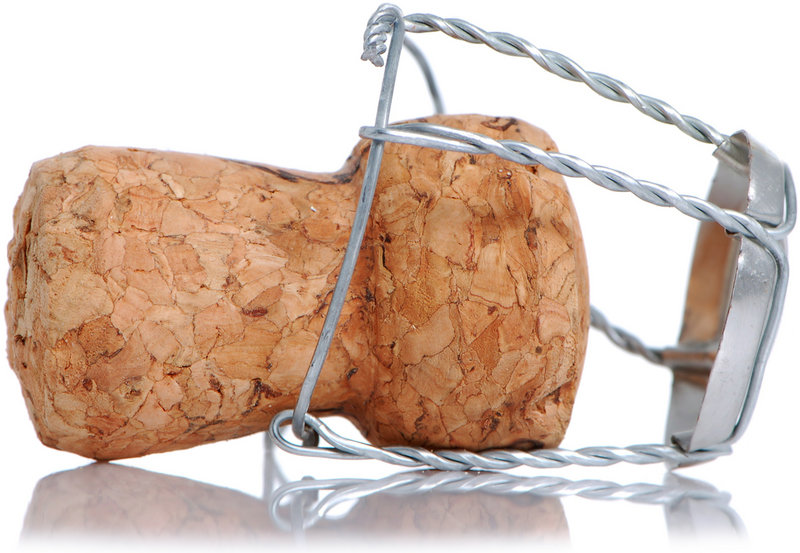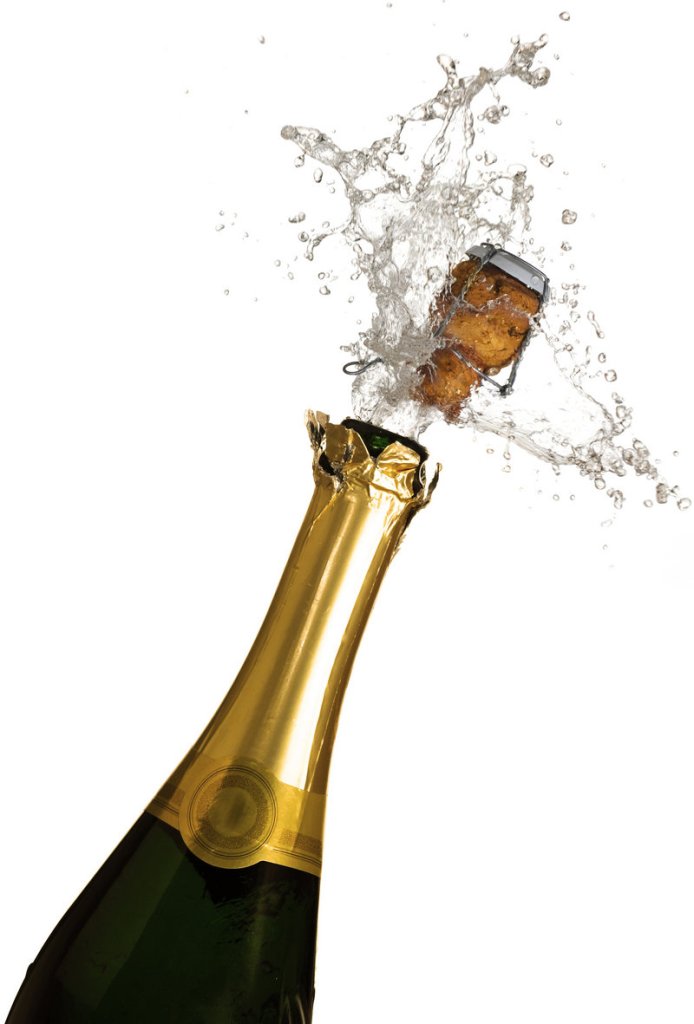New Year’s Eve without champagne is like Christmas without Santa or Easter without the big bunny.
That tickle on your nose and tongue can set the tone for the entire evening.
“Think about it,” says Jacques de Villier, owner of Old Port Wine Merchants. “You can’t be in a bad mood with a glass of champagne in your hand.”
And yet, how many people really know what they’re doing when they buy bubbly? Some revelers only drink it on Dec. 31, perhaps because they really don’t like it but feel obligated to have a glass of sparkles in their hand. So they run into the nearest grocery store, grab a bottle of $10 Cook’s and wait for change.
Then they wonder why they are always so disappointed.
Real champagne, of course, is only made in a very particular region of France, and it has to be made from three varietals of grape — pinot noir, chardonnay and pinot meunier. While big producers may force carbon dioxide into vats of wines to create bubbles, real champagne goes through a secondary fermentation in the bottle that creates a more delicate fizz.
Producers outside of the Champagne region may also use this traditional method (m?ode champenoise), but because the French are French, they have legally marked their territory, and everything else is simply called sparkling wine.
The consumption of sparkling wine has been increasing in the United States, especially among younger people, says Colleen Caron, wine buyer for Whole Foods Market in Portland.
“They tend to drink a lot of carbonation, so they’re kind of already interested in what bubbles are all about, because it’s in basically their everyday life,” Caron said.
We asked a few local wine aficionados to offer some suggestions for New Year’s Eve — from bottles that will bring you pleasure but not necessarily empty your wallet, to sumptuous, higher-priced bottles for those who want to splurge a little.
First of all, they all said most people seem to prefer a little sweetness in their sparkling wine, despite what they may tell you.
“In my world, it’s pretty common knowledge that Americans talk dry and drink sweet,” said Ezra Provost, wine guru at Havana South restaurant in Portland.
Caron agrees. “We are finding that sweet is coming to be more prominent in the sparkle world,” she said. “Even though most will say they like dry, inevitably if you show a cremant or a prosecco or something with a little bit more fruit, it seems to be well favored.”
Scot Hudson of Davine Wine Selections in Bowdoinham, a wholesale wine distributor, isn’t shy about proclaiming his distaste for dry champagne, which he says makes him sneeze and “tastes like sandpaper.”
“Roses are generally what I look around for when I buy sparkling wine, and it’s because there’s a complexity there,” he said. “It’s a different sort of style. I think rose is really beautiful in the glass. You can see it across the room in somebody’s glass.”
He also looks for the lushness of a sweeter style and things that are trendy, just out of curiosity.
One of the trendiest, more affordable sparklers is prosecco, or Italian sparkling wine. Many bottles cost under $20.
“Prosecco has a really slightly but soft-spoken sweetness to it, which I think people gravitate towards,” Hudson said. “They still perceive it as being dry, but it has a lightness to it.”
De Villier raves about a Fragolino he just got in.
Fragolino, sometimes called Italian champagne, tastes of strawberries and can be used to start with “or even finish with dessert instead of a Brachetto, the Italian sparkling red that they always say serve with chocolate.”
“People like a touch of sweetness in things,” he said. “Slightly sweet like a Moscato d’Asti. Have you ever seen the Moscato d’Asti Primo Baccio? That one’s one of our favorites. We sell it like it’s going out of style. It’s kind if a step up from Asti Spumanti.
“And then, everybody loves proseccos these days. There’s one out called Sergio. It’s kind of like the Grand Cru of proseccos. . . . It’s bright, and it’s got nice small tight bubbles. It’s a very inexpensive champagne.”
Another option is cava, Spain’s contribution to sparkling wines and a favorite of Ezra Provost.
“I like cava because they actually use the m?ode champenoise, the double fermentation method that champagne growers utilize, essentially keeping the dead yeast cells in the bottle to create the carbonation,” Provost said.
“Cava is from Spain. It’s not a regional designation, but most of the time it is coming from the Pened?in the Catalonia region on the midwest coast of Spain. It has some of that toasty breadiness that you can get from champagne, but the price tag is not attached to it by any means. Roger Goulart is a pretty good example.”
Hudson and Provost both like Gruet, a very affordable sparkling wine made in New Mexico.
“Honestly, when I first heard about it, before I even tasted it, there was this running joke between me and my friends,” Provost said. “You know how Miller High Life is known as ‘The Champagne of Beers?’ We were calling Gruet the beer of champagnes. And then I tasted it, and I was blown away by the quality. And you can find this definitely under $20 for a full bottle.” (On Havana South’s wine list, it’s $17 a bottle.)
Some of Provosts’ favorites are sparkling wines of Vouvray and Montluis-Sur-Loire from the Loire Valley, which are made from chenin blanc. Francois Chidaine from Montluis-Sur-Loire, especially, “is absolutely one of my favorites.”
Provost said it’s probably available for a little under $20 retail, “and it’s just a wonderful expression of chenin blanc of the sparkling variety.”
If you want to splurge on New Year’s champagne, names like Veuve Cliquot are often the go-to bottles.
But Caron says champagne prices from big-name producers have gotten so high now that people are looking for alternatives — champagnes that are more affordable but still have that wow factor.
“Are we all going to be impressed by Krug Rose? I believe so,” Caron said. “And does it have a huge tag on it? Yes, it does. But for half the price, there are a lot of estate-grown champagne producers that no one has every really heard of, but they’re lovely.”
Provost says for the past couple of decades, the big champagne houses have been creating a house style that is consistent from year to year, but ignores terroir.
“There’s this movement that’s been going on lately, what we call the grower champagne movement,” he said. “Essentially, these grapes are grown by a family and they’re produced on site and bottled by that family.
“So it’s a much smaller production, but they do tend to be a lot more involved in creating a sense of terroir, an expression of both the vintage and the soil, as opposed to creating a house style and trying to be consistent year after year after year.”
These wines typically range from $50 to $70. Look for names like Pierre Morlet and Jean Vesselle. Whole Foods sells champagnes from Terry Thiese Estate Selections, including bottles from growers Rene Geoffroy and Aubry Fils.
“You can get an amazing bottle of champagne for $50,” Provost said. “And honestly, if you’re spending $65 on a bottle of champagne and you don’t recognize the label, chances are it’s pretty good juice, because it’s probably a smaller label and they’re a little more interested in the quality of the product as opposed to the volume.”
Staff Writer Meredith Goad can be contacted at 791-6332 or at:
mgoad@pressherald.com
Send questions/comments to the editors.





Success. Please wait for the page to reload. If the page does not reload within 5 seconds, please refresh the page.
Enter your email and password to access comments.
Hi, to comment on stories you must . This profile is in addition to your subscription and website login.
Already have a commenting profile? .
Invalid username/password.
Please check your email to confirm and complete your registration.
Only subscribers are eligible to post comments. Please subscribe or login first for digital access. Here’s why.
Use the form below to reset your password. When you've submitted your account email, we will send an email with a reset code.